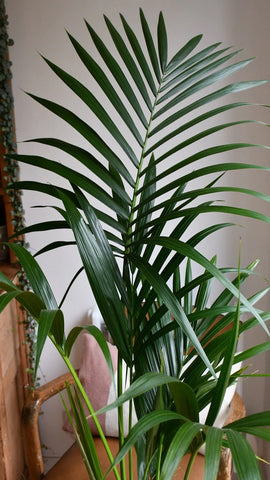Areca Palm: How to Grow & Care an Areca Palm Houseplant
About the Areca Palm
We adore the pure class of this stunning Areca palm! You probably recognise this palm even if you don’t know the name! It’s well-loved, graceful, and elegant - think 1920s hotel, mirrors, and dinner jackets! It will give your home that sophisticated feel, like walking into a movie set! Palm house plants are always popular, and the Areca Palm is no exception. Native to the tropics of Madagascar but, can also be found as close to home as the South of France!

The Areca Palm goes by many other common names such as bamboo palm, butterfly palm and scientifically, the Dypsis Lutescens. We at Happy Houseplants find it staggering to believe why areca palms have become an endangered species in recent decades, despite its abundance in tropical rainforests. When driving down almost all the street in a warm climate, you will find dozens of tall, appealing, tightly clumped palms that look very similar to bamboo.
These palms have smooth, tipped branches with sometimes golden veins which resemble bamboo branches. Their frond is large and broad and looks almost as thick as bamboo leaves. In nature, they can be viewed as privacy screens. Palms are cultivated indoors as houseplants. The seeds should be planted only during the spring months and tend to grow slowly to moderately.
Caring for an Areca Palm
Light
The great thing about these magical plants is the fact they can be grow outdoors with nature as well as indoors. Whenever purchasing a plant, the placement is crucial as the right amount of light plays a critical role to how a plant will thrive, and the Areca Palm is no exception. This houseplant likes bright light that it filtered. This is because too much sun can lead to scorching the leaves. Best practice is to place the Dypsis Lutescens near a south or west-facing window with plenty of bright, indirect sunlight.

Watering
The Areca Palm has similar characteristics with a Calathea. Their beautiful leaves, their ability to bring tropical vibes in whatever environment they are in, but most importantly, the way they like to be watered! Areca palms, like Calatheas, like moist soil and a slight period of the potting soil drying out in between waterings. The Areca also does not like sitting in soggy soil, this is because they are susceptible to root rot. Therefore, letting the soil dry out slightly has great importance. Areca Palms do not like tap water as it contains many chemicals such as fluoride and chlorine. The result of using tap water can brown and crispen its leaves, especially if the pot does not have good drainage. It is best to use rainwater or distilled water.
Soil
Just like watering, soil is an extremely important component to a houseplants’ life. A blend consisting of perlite, activated charcoal, sand and worm castings will make your Areca Palm adore you. The sand and activated charcoal helps provide excellent drainage, whilst the perlite is extremely porous absorbs water and improve the drainage. We suggest repotting your Areca Palm every 2-3 years, during the spring months as this is their growing season.
Temperature & Humidity Levels
Whether you want to place this houseplant indoors or outdoors, it will serve best in the temperature region of 18-24°C which is around 65-75°F. We suggest keeping the Areca Palm away from windows during the winter months as draughts can be detrimental. We also suggest keeping this palm away from air conditioning units and heat sources such as radiators.
As this indoor palm is native to the tropics of Madagascar, a region with high humidity levels, we need to replicate these conditions as much as possible for the Areca to reach its full potential. If the humidity in your home is too low, it will create a dry environment, making the palm prone to brown leaf tips. To avoid this, create more humidity in the Arecas’ environment by grouping your houseplants together, regularly misting its leaves or purchasing a humidifier to create perfect humidity levels in the room.

Fertiliser
This indoor palm is quiet a heavy feeder, but fear not! Our vegan liquid plant food will cater to all your Areca Palms needs. you'll find no chemical supplements in this 100% cruelty-free vegan product. Seaweed, harvested sustainably, is its secret sauce with a delicate blend of growth hormones and micronutrients that is perfect for houseplants. Feed from spring to early fall (March to September) by applying our vegan liquid plant food every other time you water your indoor plants. Simply shake the bottle well and mix 3 pumps into a litre of warm water and apply at the base of the plant.
Repotting Areca Palms
Areca Palms enjoy an ever so slightly cramped nursery pot or container with large drainage holes. Ensure that both the pot you are repotting the Areca Palm and soil will facilitate drainage as this indoor palm does not enjoy a soggy soil mix. As stated before, both activated charcoal and perlite will help promote drainage, keeping your mind at ease and your Areca Palm happy! We suggest repotting this houseplant anywhere between 2-3 years, however, keep an eye out for signs. For example, if the roots are growing out of the drainage holes, your Areca may be getting too big for its pot, or you may want to repot as salts have built-up in the soil from the water.
Areca Palm Common Pests & Diseases
These indoor palms are not susceptible to many common pests pr diseases however, that does not make them immune. This will all depend on conditions it’s in. For example, if you decide to plant it outside, they are more prone to yellowing from insect-transmitted bacterial diseases. The key is to inspect your houseplant regularly to identify any possible pest infestations before they get out of hand. Spider mites, scales, mealybugs ad whiteflies can infiltrate your Areca especially if the conditions are right. For example, spider mites love dry, arid conditions. If you spot an infestation looming, treat as soon as possible.

Areca Palm FAQ
Is Areca Palm Pet Friendly?
The Areca Palm is also suitable if you have cats and dogs as it’s non-toxic which is unusual in a houseplant.
Is Areca Palm Easy to Care For?
The Areca Palm is in the intermediate spectrum, with watering around every 3 days and medium to bright, indirect light. We recommend some houseplant experience but not always necessary with an indoor palm like this.
Is Areca Palm a Good Houseplant?
This palm is commonly grown indoors, but for it to thrive you must ensure that the conditions are similar to its native environment. A constantly warm, high humidity spot with plenty of bright, indirect sunlight, and this indoor palm will serve you well!










Thanks a lot 🙏
Thanks a lot 🙏
This information was really helpful. Our Areca palm has been thriving for over two years in our new home so it seems we’ve got it right. We don’t want it to get any bigger though. Is it okay NOT to repot it?
Leave a comment